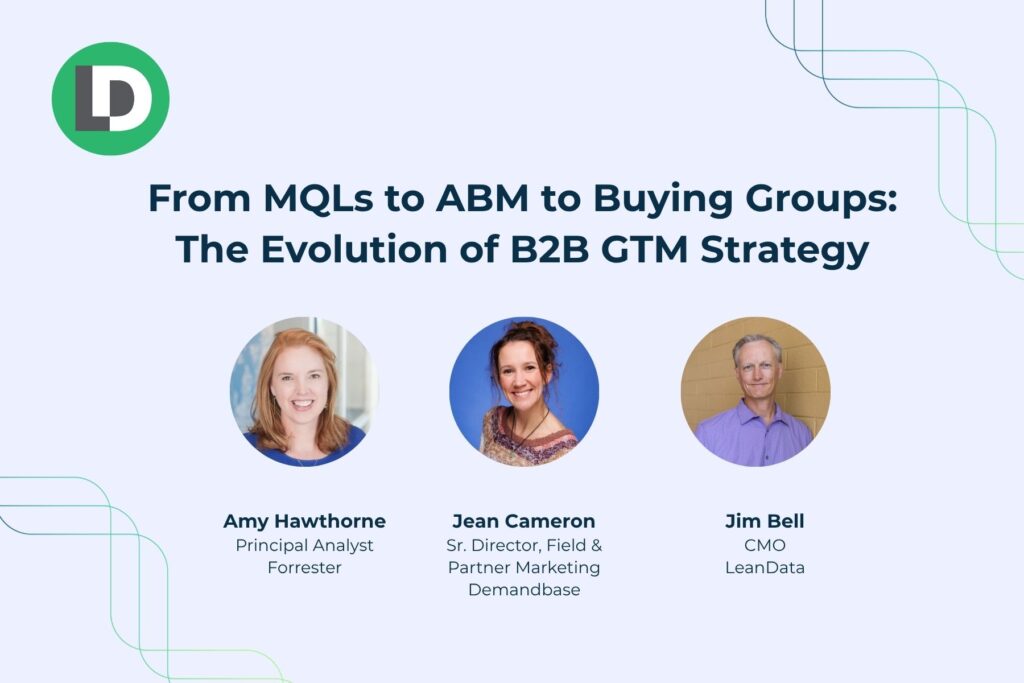Why Buying Groups Are the Next GTM Advantage
B2B Teams Are Shifting From MQLs to Buying Groups


Most B2B revenue teams are built around individual leads. But here’s the problem. Deals rarely happen because one person filled out a form.
In a recent webinar hosted by Forrester’s Amy Hawthorne with panelists Jim Bell, CMO of LeanData, and Jean Cameron, Sr. Director of Field and Partner Marketing at Demandbase, the group made one thing clear: the most effective go-to-market teams no longer rely on individual leads. Instead, they’re transforming their GTM motions around Buying Groups.
If you’re still scoring MQLs while your prospects are coordinating decisions across 13 different stakeholders, it’s time to rethink your model.
Let’s explore six practical shifts your team can make, based on what these experts shared.

1. Make Sure You’re Buying Group Capable
Buying groups are not a new concept. Marketers have been targeting multiple personas for decades. What’s new is our ability to capture and act on the digital signals of each stakeholder and aggregate them at the opportunity level.
According to Forrester, when revenue teams identify and engage at least three verified buying group members, they see a 20 to 50 percent improvement in conversion rates from qualification to closed-won.
To get started, Amy recommends three steps:
- Capture signals from multiple personas, including first-party and third-party data.
- Update scoring models to consider group behavior, not individual actions.
- Train sales development reps to recognize patterns across accounts, not just high-score leads.
Jim Bell emphasized the importance of having the right structure and process. “Data, process, and change management are critical,” he said. “And often overlooked.”
2. Find Overlooked Opportunities Already in Your CRM
Sometimes the best opportunities are hiding in plain sight.
Forrester found that teams who look beyond the MQL can uncover 10 to 20 percent more qualified pipeline just by analyzing multi-person engagement that never hit traditional lead score thresholds.
LeanData’s platform helps teams surface these overlooked signals by identifying when multiple stakeholders from a single account are engaging, whether or not they’ve filled out a form. These kinds of early signs often mark the beginning of a buying journey.
3. Use Intent Data to Discover Hidden Opportunities
Many potential buyers fly under the radar. They’re researching solutions anonymously. They’re not attending your webinars or clicking your emails. But they’re actively looking for a solution.
Demandbase helps uncover these “hidden opportunities” by pairing third-party intent data with AI-powered signal detection. When these signals are mapped to known personas, marketing teams can activate relevant programs before sales even knows there’s a deal in motion.
According to Jean Cameron, organizations that apply this kind of detection see 5 to 15 percent more qualified opportunities uncovered and prioritized for sales.
Her advice? Don’t assume a single engaged contact is your buyer. “Swarm the account,” she said. “Target every persona in the buying group with tailored content.”

4. Design Programs That Expand the Buying Group
Once one member of a buying group is engaged, the goal becomes expanding that engagement.
For example, if your “Amy” persona fills out a form, that should trigger tailored outreach to “Jim” in IT and “Jean” in procurement. Demandbase and LeanData enable this kind of coordinated response through automated triggers, routed actions, and enrichment.
Forrester shared that companies proactively engaging full buying groups saw:
- Higher conversion rates
- Larger deal sizes
- Faster sales cycles
One global tech company saw a 2.6x increase in deal size and a 17 percent lift in win rates after implementing this approach.
![]()
5. Act Early on Anonymous Signals
On average, each B2B buyer logs 18 interactions in a single purchase journey. Half of these happen before a company knows who the buyer is.
This is where early signal engagement comes in.
By recognizing behavioral cues from anonymous visitors, companies can proactively serve relevant content, trigger outreach, and guide users into revealing themselves. Jean shared a story of a customer who saw a competitor being researched on G2. Using that signal, the team activated a multi-channel campaign targeting the buying group.
The takeaway? Don’t wait for someone to raise their hand. Use tools that detect early-stage interest and let you engage before your competitors do.
6. Support the Self-Service Buyer
Today’s buyers want control.
In fact, 67 percent of B2B buyers are under 45. Many prefer to research independently, avoiding live calls until they’re ready.
To stay relevant, marketers need to ensure that content, demos, pricing pages, and interactive tools are easy to find and free from friction. More importantly, these assets must match the needs of each persona in the buying group.
The goal isn’t to replace sales. It’s to meet the buyer where they are on their terms.
Start Small, Scale Fast
The shift to buying group engagement may feel big, but it doesn’t have to be overwhelming. Many organizations are already doing parts of this work. The key is connecting those efforts into a more intentional strategy.
Start by identifying who your actual buyers are, not just individuals, but the group making the decision. Then, map signals across that group, engage them with relevant programs, and rethink handoff models between marketing and sales.
You don’t need a massive overhaul to see results. One team started with just ten accounts and gradually expanded its buying group motion. Another saw deal size and win rates climb within a single quarter.
Buying group strategies deliver real impact: more qualified pipeline, stronger conversion rates, and better alignment with the way people actually buy.
The bottom line? The future of go-to-market strategy isn’t about getting more leads. It’s about engaging the right people, at the right time, in the right way.
See how Demandbase helps unify marketing, sales, and customer success around shared goals.




